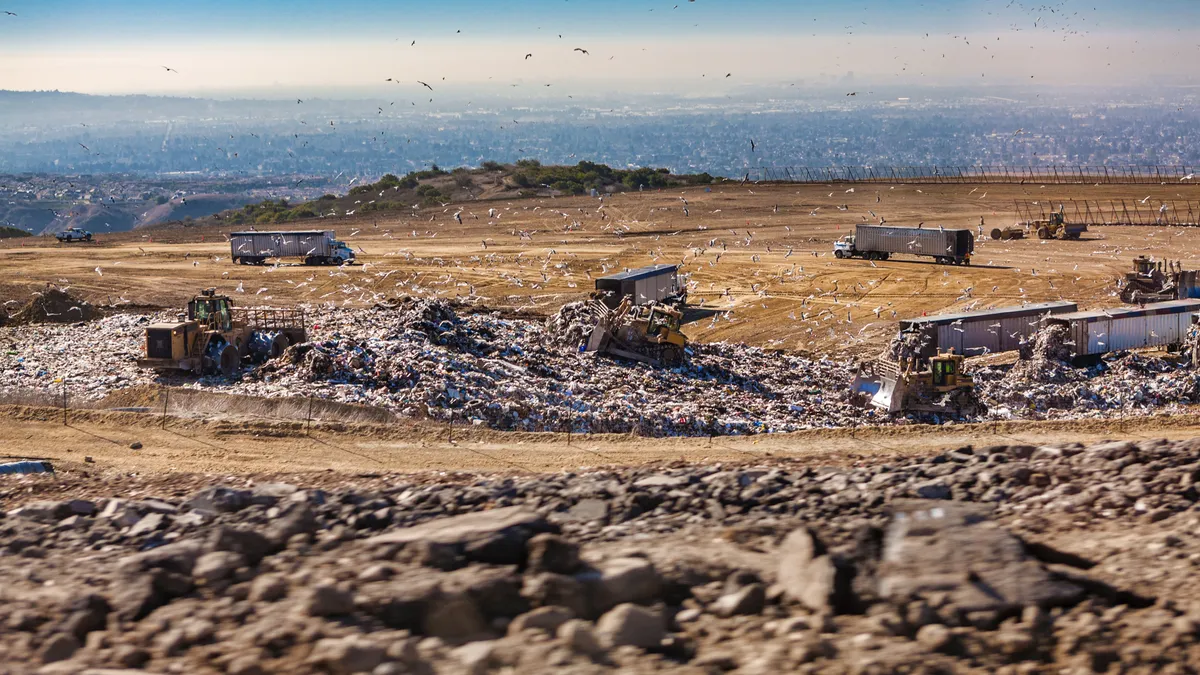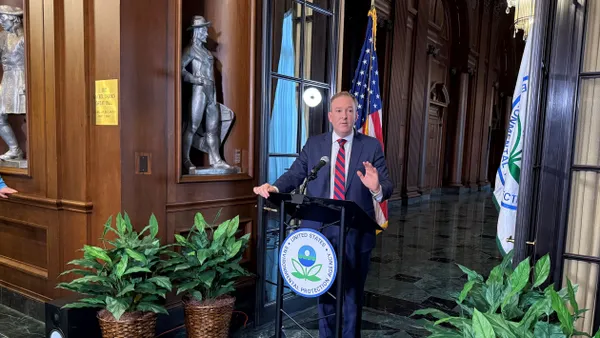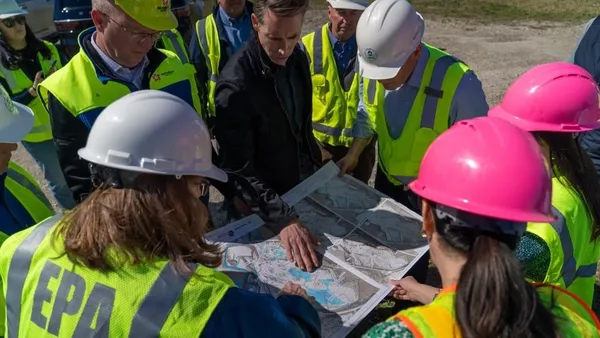Dive Brief:
- Overall emissions from waste declined by about 2.3 million metric tons of CO2e, mostly due to increasing recovery in landfills, according to the waste chapter of the U.S. EPA's 2021 emissions report released Thursday.
- The overall waste sector, which includes landfills, wastewater treatment, composting and anaerobic digestion, generated 169.2 million metric tons of CO2e. Emissions from the incineration of waste, which is categorized under energy, totaled 12.5 million metric tons.
- Anaerobic digestion at biogas facilities was included for the first time in this year’s report, which estimated that the facilities generated 200,000 metric tons of CO2e in 2021 compared to 2.6 million metric tons from composting.
Dive Insight:
Landfill emissions have been in the spotlight as the U.S. works to decrease its greenhouse gas emissions, particularly potent methane emissions. While the waste sector (minus incineration) accounts for 2.7% of all U.S. emissions, landfills are the third biggest source of methane in the country.
The reductions in waste emissions came even as overall emissions in the country rose in 2021, due in part to increased economic activity following pandemic lockdowns. The downtick likely came from a mix of factors, including ESG-related pressure from investors and shareholders and improving monitoring technology, said Ray Huff, SCS Engineers' national expert on greenhouse gas monitoring and a vice president with the firm.
That improved technology is a byproduct of the movement toward gas collection that began thanks to EPA rulemaking in the 1990s, but has been supercharged by new fuel incentive programs and greater scrutiny on methane emissions.
Methane accounts for roughly half of landfill gas emissions, but regulations have long focused on reducing volatile organic compounds emitting from landfills, which make up a fraction of a percent of overall emissions.
Systems to capture VOCs have helped manage greenhouse gas emissions in landfills over time, said Anne Germain, chief operating officer and senior vice president of technical and regulatory affairs at the National Waste & Recycling Association. Meanwhile, programs like the EPA’s Landfill Methane Outreach Program have incentivized methane collection since 1994, making the technology common at landfills today.
At the time, the EPA also began using models to measure landfill emissions, a move that was deemed necessary since emissions from landfills come from a wide swath of land rather than a single point source, as they do for factories, Huff said.
"The thing that doesn't exist is a big, super gigantic plastic bag to put over a landfill. If somebody could do that, then they would honestly know what the emissions are from the landfill," Huff said. "All we can do is extrapolate."
But a growing list of energy incentive programs focused on carbon intensity, including the EPA’s Renewable Fuel Standard, California’s Low Carbon Fuel Standard and Oregon’s Clean Fuel program have made investment in RNG facilities or other advanced emission capture systems more appetizing.
Germain said those systems, and other emerging technologies like satellites, are an improvement over the EPA’s models, which calculate based in part on waste tonnage rather than real-time or regular monitoring.
“If you're doing a flyby once a year and extrapolating over the course of the year, we're gonna probably say, 'Eh, that's probably not good, or not good enough,'” Germain said. “But if you start doing it once a month, once a week, every few days, or even better, continuous, then the validity of that data starts to be much, much higher. And that becomes some really valuable data.”
The EPA has signaled an interest in adjusting its models to more closely align with real-world emissions. The agency entered into a consent decree with environmental groups in February to reexamine its models for non-methane landfill emissions, which could prompt the first change since 1998. In Huff’s view, it’s time for a modernized emissions accounting process for greenhouse gas emissions as well.
"Technology is moving forward, shouldn't the regulatory infrastructure for that evaluation move forward too?" he said.
There are other fine-grained details that the model may obscure. The EPA noted it has yet to release detailed findings on the pandemic’s effects on the waste industry, in part because its models often rely on projections rather than real-world data collection.
As a professional who helps landfill operators calculate their emissions, Huff has seen the way packaging volumes rose in landfills while certain fast food containers, for instance, declined during stay-at-home orders. But he said the knock-on effects of the pandemic and the way they shifted waste habits will likely have a light footprint in greenhouse gas emissions data, if they have one at all.
“That's the sad thing about this, is that even the mandatory federal reporting that landfills do is based on models, and those models don't allow you to have a lot of different waste characterization,” Huff said.
He’s also looked at some early data from landfills where their gas collections systems do allow for more fine-grained measurement of changing emissions, but the effects appear to be muted.
“That said, it's still early in the game,” Huff said. “So I reserve my final opinion.”














